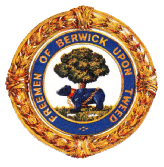Berwick-Upon-Tweed Town Hall
Marygate
As early communities evolved they began to develop trade. The centre of the Community became the market, where transactions were agreed. In time this location was designated by the erection of a Merket Cross. Originally this would be a wooden marker post, but over a period of time this would be replaced by a stone cross. In Scotland these were often a carved Celtic Cross. The market was also the location of the tron or public weighbeam. The Guild official responsible for operating the weighbeam was known as the tronar. In 1364 King David II ordered that all burghs were required to have a tron and appoint the office of tronar.
In time covered structures were added and these were known as first the Berefret and then the Tollbooth. The location of where the original Merket Cross stood in Berwick or where the original Tollbooth was erected can not be determined for certain. The Berefret was one of the locations named during the drawing up of the Laws of Berwick which were prepared between 1248 and 1294. In the reign of Alexander II the mayor, burgesses and the Community purchased a prison for the Burgh, which may have been at the site of the Tollbooth. The present site of the Town Hall was bequeathed to the Guild by a burgess, Simon Mausel, in the time of Alexander III. It is reasonable to assume that at least from that time the Tollbooth was located at or near the site of the present Town Hall.
The first mention of a tollbooth is in the later part of the thirteenth century. The tollbooth must have been damaged during the siege of 1333 as there is a record of the expenditure in the Chamberlain's accounts in which it is referred to as "The house called the Tollbooth in which the King's pleas are held". During the sacking of the town by the Scots in 1405 the whole town was burnt. Henry IV made a grant out of the town's customs for the Tollbooth to be repaired or rebuilt by the Burgesses.
The first record of the use of the Tollbooth for a meeting of the Freemen in Council is in 1511. The main use of the building would appear to have been as a Court, although it was also used as a prison and would appear to have been used as a Met or office for weights and measures. Shops inside the Tollbooth were let to Burgesses. This building would probably have been of timber construction.
An ordinance from Sir Nicholas Strellie, Captain of Berwick, in 1552 includes a reference to the Tollbooth, stating that the Freemen should be compelled to make up their Tollbooth, which should be their Council House and their prison, the want of which hampers justice.
Their is also reference to 'the prison in the wall'. This along with outhouses for the garrison was on the walls near the river. This prison was said to be of the common sort and therefore dismally dull. This prison may have been associated with the garrison.
Speed's map of Berwick dated 1564 shows the 'Tolebooth and State House' at the site of the present Town Hall. It also shows two ancient market crosses, one to the east and one to the west of the Tollbooth.
At the end of the sixteenth century a new Tollbooth was built. The plan of 1610 shows this as a large building with a square tower on the site of the present Town Hall. This building was replaced in 1669 by what was termed as a Town House designed by George Milburn from Newcastle. It included a steeple or spire on stone arches and had a clock and bell. It was still referred to as the Tollbooth.
The Guild was petitioned in 1652 by the Goaler, George Frost, who stated that he had been goaler for nine years and never had any benefit as his standing wage could scarce pay his house rent besides other necessities. He was granted œ2 per year to be paid quarterly.
The forefront of the Tollbooth and the area about the Market Cross were paved in 1653 along with the Tollbooth stances.
In 1657 Cromwell, the Lord Protector, visited Berwick. The Guild ordered that the bells be rung and that the town's colours be put on the Tollbooth turret. The Mayor went to the Parish Church accompanied by the Guild in their gowns. To balance this day, three years later the accession of Charles II was welcomed when the bells were rung and bonfires blazed.
The prisoners in the Tollbooth were generally expected to provide their own keep while in goal. However the Guild paid an allowance for prisoners without income. In one case in 1683 the Mayor drew the attention of the Guild to a soldier, Thomas Wise, who had killed a fellow soldier and was likely to starve having nothing wherewithal to maintain him. The Guild ordered the Recorder to try Wise at the goal delivery according to law. A Poor Committee was set-up which made an allowance to prisoners in need. This eventually settled upon a common allowance.
A number of prisoners escaped from the goal in the Tollbooth. One of the most celebrated was the escape of Lancelot and Mark Errington in 1715. They had been taken prisoner after attempting to capture Holy Island Castle during the Jacobite rebellion. The escape from prison was organised by Thomas Bowring, the elder, a burgess of Berwick. Tools were conveyed to the Erringtons by Thomas Hunter, Thomas Peach and a man called Young. The flagstones under the door were pulled up and a tunnel dug under the foundations of the old goal. The town was closed for the night and the prisoners were let down over the town walls on a rope just above Fishgate by Thomas Bowring, the younger. They took the Custom House boat and crossed the River Tweed eventually escaping to France. After the general pardon which followed the rebellion, Lancelot Errington returned to Newcastle where he died on hearing of the defeat of the Jacobites at Cullodon.
The prisoners in Berwick goal at that time were;
Lancelot and Mark Errington
William Galbraith, a Custom House officer sent in by General Carpenter for having countenanced the rebels.
Samual Forster, a non-juror.
Thomas Darking, on information that he was in arms against His Majesty at Morpeth.
Walter Ashley, William Butler and James Pentland, papists.
William Moor, who deserted the rebels at Doddington and claimed he was forced away with them.
John Farrar, a papist, suspected to have been in the rebellion.
George Brown and Mark Moody, two papists, one of them having been away from home at the time of the insurrection.
Captain Kerr, who had 'unfortunately' killed a gentleman in half pay named Miller.
By 1747 the Tollbooth was showing signs of decay and the steeple or Bell Tower of the Tollbooth was in a serious condition. It was recorded that this was believed to be the third Tollbooth built on this site. It was d decided to build a new Town Hall. A Committee was formed in 1749 to consider the building of a new "Tollbooth, steeple and proper goal". The Guild ordered that every burgess living within the town who failed to attend the Guild Meeting to discuss this matter was to be fined six shillings and eight pence (33p).
At this time events caught up with the Guild as in December, 1749, the Tollbooth fell down, leaving the Bell Steeple in a dangerous condition. A new Town Hall Committee was formed to erect not only a new steeple and Tollbooth, but also 'a strong goal for the safe and secure keeping of all malefactors and other offenders'. An additional tax of two shillings (10p) per acre was placed on all meadows and it was ordered that all other fields be divided into lots to allow them to be taxed. This was still not enough to build a new town hall and a further œ5,000 was raised by two annuities which paid œ200 per year. These were taken up by two elderly Freemen living in London. They were raised through the Mayor's brother, Mr.George Temple, who lived in London. The Corporation debt at this time was paying 5% interest and the capital was offset against the debt until it was required for the new Town Hall.
In July 1750 the old building was authorised to be demolished by Joseph Dods, a local carpenter and member of the Guild. Dods was born in 1716 and served his apprenticeship to his father as a carpenter and builder. He was ordered to recover the bells, the clock and any other material worth saving. At the same time it was decided to have a new peal of bells and a new clock. The old bells were s sent to London and recast at a cost of œ300.
Local builders and carpenters were asked to take part in a competition to determine a suitable design for the new building. The winning design was submitted by Joseph Dods. The design used the existing building with a new section on the west side. As Dods had no previous experience of the design of major buildings, the Guild sent his plans to architects in London for approval. One of these Architects was Samuel and John Worrall. They submitted their own design with two elevations and one section. They were paid thirty one pounds ten shillings (œ31.50p). It would appear that the Architects reflected the ideas contained in a book on classical architecture written by James Gibb, a Scotsman. The Church of St.Martin's in the Field in London, which was built twenty five years before Berwick Town Hall, reflects these same ideas.
Joseph Dods submitted a new design which showed a remarkable similarity to the design put forward by the Worrals. There were minor modifications and the addition of a portico. Joseph Dods modelled the whole building in wood and this model stood for many years in a garden on the north side of the walls. The Guild chose Joseph Dods as the Architect for the new Tollbooth on 23rd. October, 1750.
DESCRIPTION.
The Town Hall is owned by the Berwick-upon-Tweed Corporation (Freemen) Trustees. It occupies a prominent place in the town at the lower end of the High Street facing west. The spire rises to 153 feet and is the main feature an the skyline of Berwick. Construction is of local sandstone and the total length 132 feet (40 metres). The portico is supported by four massive Tuscan columns, 32 ft,(9.75 metres) high by 17ft.6 ins.(2.9 metres) diameter. These form the entrance to the Guild Hall. On the portico is carved the name of William Temple who was Mayor in 1754 when the first part of the building was completed. Above this is the bell tower, the clock tower, the octagonal cupola and the spire, which is roofed with timber, covered by slate and lead and enclosed in a ballustrade. This is topped by the weather vane.
Considerable weathering takes place of the sandstone blocks which comprise the outside of the building. Sandstone from Wooperton Quarry have been used to replace some blocks. In 2005 part of a block fell off. Emergency repairs of the outside were completed of 2005/6
The ground floor originally contained shops and some cells, with an open market to the east, which was called the Exchange. This was the location at which the hiring of servants took place and was also a market for poultry and dairy products. The ground floor has been substantially restored in the early 1970s with the original cells at the west end made. into a coffee house and gift shop. The east end is now referred to as the Buttermarket. For many years there were public toilets in the Buttermarket installed by the Borough Council, which detracted considerably from its appearance. Eventually the Borough Council removed these toilets restoring the flagstones and gates. This area is now open and provides an attractive entrance to the coffee house. The area was used for some time by the WRI for sale of garden products and baking during market days. It is occasionally used by voluntary organisations with permission from the Trustees.
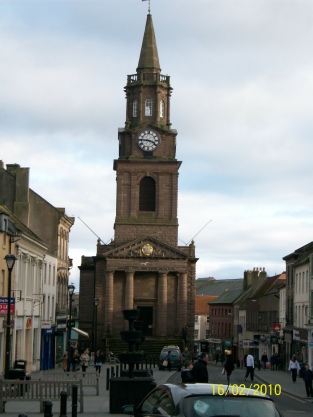
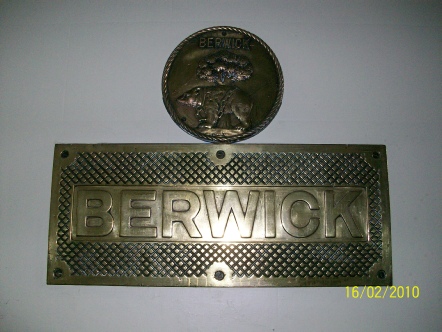
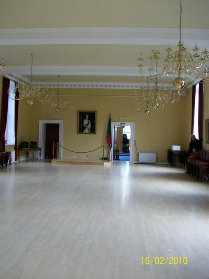
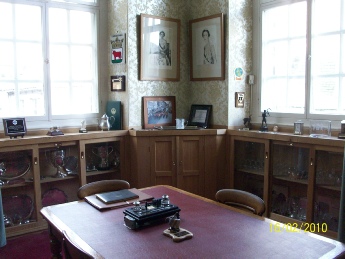
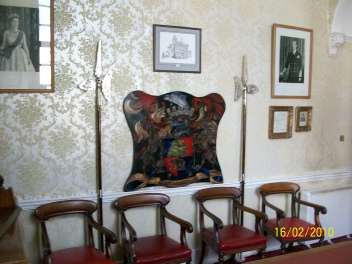
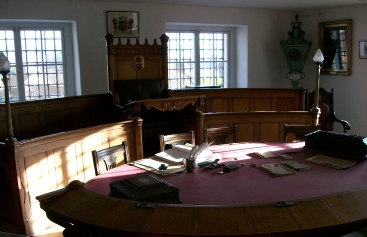

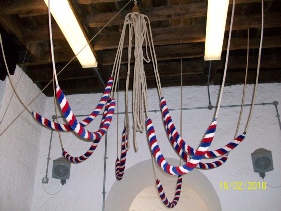
The main access to the first floor is by twelve stone steps at the front or west end of the building giving access through the Tuscan columns to the main entrance. Inside the main doors there is an anti chamber which is maintained in the original condition as built with stone flags. On the right hand side there is a memorial to the Freemen of Berwick who were killed in the two world wars. A wreath is hung an the memorial by the oldest freemen at the beginning of each Guild AGM in November. At the extreme right is a ramped access to the Guild Hall. On the left is the name plate and plaque bearing the ancient arms of Berwick. This was taken from the tenth HMS Berwick when she was broken up. On the floor under is an iron chest which originally was used to store the Guild archives. This used to stand in the north corner of the Guild Hall. These records from prior to 1843 are now held in the Borough Archives. Those post 1843 are held in the Freemen's Room on the upper floor of the Town Hall. On the extreme left is the entrance to the stairway to the upper floor.
Through the second set of doors is the main Guild Hall, which is 60 ft (18.3 metres) long and was has an actual height of 17ft.(5.18 metres) although this has been reduced by the installation of the wood floor. The Guild Hall was formerly used for the meetings of the full Guild, for local and parliamentry elections and civil and criminal courts. The original stone flag floor was covered by carpet in the 1960s. However the unevenness of the flagstone caused
excessive wear. In 1988 the present beech flour was installed above the flagstones. At this time the hall was completely refurbished with new heaters and the installation of new lighting. The hall was also redecorated. Curtains were also fitted, although these would not have been part of the original furnishings. The armorial coat of arms used by the former Borough was
retained above the west door. Amongst the pictures at present an display in the Guild Hall is a painting of Joseph Fleming, who was Mayor of Berwick and a leading Freeman. He was one of the architects of the 1926 Act. The wood floor was sanded down and repolished in 2005. New slim line heaters were fitted at that time.
The second hall or anteroom an the east side of the Guild Hall and is 47 ft.(14.33 metres) long by 16ft.(4.88 metres) high. It is used for meetings, including the Freemen Committee. It is also be hired out at the discretion of the Trustees. On the wall there is a painting of the town as seen from Tweedmouth at the beginning of the 18th.Century. By looking carefully it can be seen that there is a painting under the present scene.
There is also a document relating to a visit to Berwick, Pennsalvania, USA, by Joseph Fleming, who was a Freemen and former Mayor of Berwick. This led to the first Twinning of the two Berwicks. Above the entrance to the Council Chamber two clock hands show the time 11 o'clock this being the time at which Council Meetings used to be held.
At the east end of the building there is the Council Chamber. This is used by the Borough Council, Freemen and Trustees. The present furnishing dates from the reform of local government in 1974. The furnishings from immediately prior to that date have been restored an the second floor. The Borough Quarter Sessions were held in this chamber until 1951. There are plaster busts of Queen Victoria and Prince Albert in niches at the west end of the chamber which are dated 1887 and on the north well there is a plaster relief figure of Justice made in 1789 by local artist, Joseph Alexander, who was paid œ5. The ancient Berwick Coat of Arms are above the door to the anteroom and the new Coat of Arms are shown an the front of the Mayor's table. The reading table an the Mayor's table was presented by Lt.Cl.Crossman, a Freeman and former Mayor of Berwick.
The ancient coat of Arms was used by Berwick from a very early date. The Coat of Arms used by the Build and the Borough were the same. The County of Berwick, which remained in Scotland, used the same Coat of Arms. Thus this Coat of Arms was used by three different organisations. The County of Berwick applied to the Lord Lyon in Scotland to register their Coat of Arms. This was accepted and after the reorganisation of local government in Scotland in 1975, the new Berwickshire District Council also registered this Coat of Arms. Berwick
Borough applied to the Knight Garter to register their ancient Coat of Arms in 1958 after the County of Berwick had registered their Arms. This was refused by the Knight Garter an the grounds that the Coat of Arms was already registered to Berwick County. A new Coat of Arms was devised which is used by the present Borough. The Guild continues to use the ancient Coat of Arms which it has used for at least 500 years.
There is a side entrance to the Town Hall on the north end. This entrance is that normally used except for major functions. There are notice boards outside this entrance which give details of Freedom ceremonies and other items referring to the Town Hall. A staircase from this entrance gives access to the corridor by the anteroom and to the second floor. In 1973 a partition between the corridor and the stairway was removed. There are gents' toilets on the ground floor, while an the first floor there is special ladies toilet created for the visit of Her Majesty Queen Elizabeth II in 1964.
There had been a kitchen to the north of the corridor for many years. During the restoration of 1989 to 1990 this was converted to a full commercial kitchen to allow cooking for major functions within the Guild Hall. A direct doorway from the corridor to the Guild Hall was also opened up to avoid entrance through the anteroom.
The Mayor's Parlour is located at the north east end of the corridor. This room is not generally open to the public, and is used by the Mayor for robing and entertaining special guests. The Mayor and the Sheriff's robes are kept within this room. it also contains a number of items of historical interest. These include most of the plate held by the Guild and the Borough, the Mace, the ceremonial Halberds dated 1685, a wooden chest made from carved panels from
Berwick Castle chapel and the Freedom ticket for Lord Nelson. Over the period 1995 to 2005 wood panels and door were installed to enclose the shelves and the cupboard containing the Mayor and Sheriff's robes.
The second flour was the old town jail or goal. This was in use until. 1849 when the new prison was built in Wallace Green which is now the Council Offices. The side entrance stairway gives access at the east end.
The first room was the original debtors dayroom. A set of steps leads to the flat roof where in former times prisoners took their exercise. The east end area of this room has a reconstruction of the Court and Council Chamber from the first floor which was in use before 1974. The original furniture was retained and reconstructed in this room. There is also a collection of prints of old Berwick photographs collected by David Moor and retained in the Freemen's Room. The cells leading off this room and the area which has been used for reconstructing the Court Room was the flat of the Town Hall Caretaker. The last caretaker in residence was Mr.Manderson, a freeman a+ Berwick. The cells an the north side in this area now contain artifracts from Berwick's history. This local collection was put together by the Sergeant at Mace J.H.Weatherburn, BEM, and the Town Hall keeper, J.Q.Allan in 1984 and received the
EBDA Award.
The cell on the south side is the Freemen’s Room and contains books and papers belonging to the Guild. These include the Guild records since 1843. The Guild records prior to 1843 are held in the Archivist’s building in Wallace Green. There is also a collection of old photographs of Berwick collected by David Moor and a number of books and pamphlets which have been published regarding Berwick. It is not normally possible for the public to gain access to this room.
The central area of the second flour was formerly the criminals" or felons" day room and this and the adjoining cells have been preserved in their original form. There are several interesting carvings an the wood walls of the cells, which were made by former prisoners. The east cell on the north wall was a security cell, virtually an iron cage. The next cell was the women’s cell.
This has a wooden bed upon which four could sleep. When there were more than four female prisoners, they had to sleep an the floor or await their turn an the bed. The cell at the south end was used for short term prisoners, often sailors or soldiers from the garrison. This cell has a lot of grafitti carved into the walls. On the apposite side of the cell block there is the drunkards" cell with a large sloping wooden bed. The condemned was originally two separate cells and has no windows. It was in this cell that Grace Griffin was confined in 1823 before becoming the last person to be hanged in Berwick. Several items of gaoler’s equipment are an display. These include keys, leg irons, manacles and branding irons which were used by prisoners to be transported.
A corridor from the Felons' cells leads to a stairway back down to the main entrance antechamber. Off the corridor there are double doors which lead to the bell chamber. It is from this area that the bells are rung.
